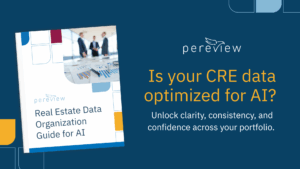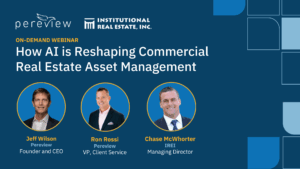In commercial real estate asset management, effective reporting and data management are essential for making informed decisions, optimizing performance, and visualizing risk. As critical as these factors are, they come with more than their fair share of challenges.
In fact, modernizing technology was prioritized by Deloitte as the focus for the industry and even called “mission-critical” for firms in 2024. Below, we’ve identified the top five challenges to technology maturity and the key criterion to consider when evaluating a modern asset management platform.
1. Siloed data
Investments often involve different property types, multiple partners, complex investment structures, and other complications. Because of these factors, data is often scattered across various spreadsheets, documents, and systems. In many cases, this data is even further fragmented across departments, making it even more challenging to gain a comprehensive view of your investment portfolio. It also opens the door for errors and inefficiencies.
As a result, one of the biggest hurdles in reporting is trying to manage siloed data. How you achieve alignment and clarity in your data is the real difference-maker.
The answer:
- Look for a platform that centralizes all your data into a single platform. This allows you to access, manage, and analyze your data from a single source while being sure that you’re seeing accurate, up-to-date information.
- This consolidation eliminates data fragmentation and provides a unified view of your investments that can be accessed quickly and easily.
Learn more: Singerman Real Estate Streamlines Asset Management and Reporting with Pereview
2. Data accuracy
Accurate data is the key to making sound investment decisions and staying compliant with reporting requirements. Real estate data can be intricate, with updates and changes happening constantly and coming from multiple sources.
Important edits are often being made at the same time by different people with distinct roles in a variety of different spreadsheets or files. This increases the potential for inaccuracy in data entry or outdated information, contributing to what is already a “bad data” problem for commercial real estate.
This can lead to costly mistakes and do considerable damage to your firm’s reputation.
The answer:
- Choose a platform that employs automated data ingestion, along with validation and reconciliation processes to ensure accuracy.
- Additionally, look for one that integrates seamlessly with a wide range of data sources and systems to minimize the risk of manual data entry errors. Finally, real-time data synchronization will keep your information up to date.
Learn more: Save Time on Data Load & Validation with Data Management Services
3. Time
Generating comprehensive investment reports can be an incredibly time-consuming task, particularly when dealing with large portfolios, multiple stakeholders, and varying data sources. The administrative task of creating reports manually not only takes valuable time, but the tedious manual aggregation of multiple pieces of information from varying sources also increases the likelihood of errors.
The answer:
- To make this process much more efficient, teams should look for software that can automate the creation of reports quickly and efficiently.
- A platform with a library of report templates and the capability to customize and automate tasks like quarterly asset management reports will save your team hours of digging for data in disparate sources and formats. This will ultimately allow them to focus on strategic tasks that add value to your portfolio.
4. Routine, repetitive reports
Every asset may have a variety of stakeholders, each with their own unique reporting requirements. Whether that’s equity investors, lenders, developers, institutional investors, or others, stakeholders often have their own specific reporting needs/preferences, which can increase the time it takes to locate data, validate that data for accuracy, generate reports, and perform other necessary tasks.
The answer:
- Because these required reports are repetitive by nature, they can often be automated.
- Teams should use a software platform that can automate these reports to free up time for more specialized or custom reports (see #5 below).
Learn more: From ‘Nightmare’ to Robust, Data-Based Decisions
5. Specialized and custom reporting
Routine reporting is most often predictable, allowing you to plan out your time to perform it. However, there are instances where one or more stakeholders may want a report that isn’t so predictable. This is where the “fire drill” mentality comes in, where an analyst has to scramble to find the right data for that report, verify its accuracy, separate out the pertinent information, and finally, create the report. And these are often highly time-sensitive reports, adding further levels of complication.
The answer:
- Software can simplify what would normally be stressful, time-consuming tasks.
- In many cases, these solutions can generate time-sensitive custom reports with a single click – while also ensuring the data is accurate and up to date.
Real estate asset management and reporting present several challenges, most notably siloed data, accuracy issues, time-consuming processes, multiple stakeholders with unique reporting requirements, and the lack of access to custom reporting. The best way to address these challenges effectively is to look to technology, specifically a solution that centralizes data, automates reporting processes, ensures data accuracy, and provides options to ease custom reporting. Choosing a comprehensive solution that aligns with these criteria allows you to make the most informed investment decisions and thrive in a competitive market.



